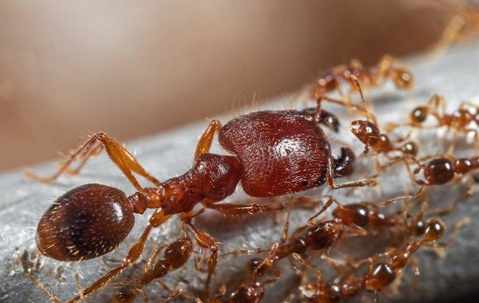Salt Lake City homeowners deal with dozens of different kinds of ants, so when we see them around our property, they don’t really catch our eye too much. Sure, watching a line of ants marching in your driveway might make your skin crawl, but it won’t make you stop what you’re doing, especially not with a busy schedule. The more you learn about harvester ants, though, the more you’ll want to figure out how to keep them off of your property completely.
Hazardous Harvesters
While some of the ants you’ll see on your property are harmless, harvester ants are a different story. Whether they’re in your yard or in your house, they are a threat to both children and adults because of their painful sting, which can cause an allergic reaction in many cases. These ants, which are typically orange/red or brownish/black are incredibly small (just a half-inch long at the most). They get their name from the way they’ll search for, collect, and harvest seeds to feed their colonies.
Since they spend most of their time collecting seeds, they’ll typically remain outside. However, they might wind up in your home if they think it could be a viable source of food. One of the easiest ways to spot harvester ant activity on your property is to look for bare spots in your yard and soil. Their mounds are built low to the ground, but they’ll always create bare soil in areas of high activity.
Prevention: Inside And Out
In order to protect your yard (and anyone who enjoys playing in it), harvester ant prevention needs to be a priority. Ideally, you'd be able to keep them out of your yard entirely, but that's not a realistic or possible solution for DIYers. For now, you’ll want to focus on keeping them out of your house.
If harvester ants decide there aren’t enough seeds in your yard to feed the colony, their focus will switch to other insects as a source of food. When they feel like there is a good chance to find those insects in your home, they might try to find a way in. Therefore, the best way to keep them out is to limit the number of pests inhabiting your home by practicing prevention methods, such as:
- Sealing up cracks and crevices. While you may not be able to keep tiny harvester ants out, you can keep other insects out by limiting their easy access points. You can apply caulking around windowsills and use new weather stripping on all exterior doors.
- Proper food and trash storage. Limiting pests’ access to food sources like stored food or trash can greatly reduce your chances of infestation. Both food and trash need to be stored in tightly secured containers.
- Regular cleaning habits. Limiting loose crumbs by wiping off counters and tables after meals can help limit pest attraction. You’ll also want to mop and vacuum regularly to keep crumbs off of the floor.
- Moisture management. Many pests love damp environments, so using a dehumidifier in the crawl spaces and monitoring your pipes for leaks can limit moisture buildup and reduce the number of pests who want to invade your house.
Keeping harvester ants out of your house is good, but harvester ants are still a scourge in your yard and could wind up ruining your outdoor fun. Instead of relying on the inconsistent results of store-bought ant baits, you can keep your Salt Lake City yard safe with quarterly treatments from pest control technicians. Contact White Knight Pest Control for more advice or assistance today.

